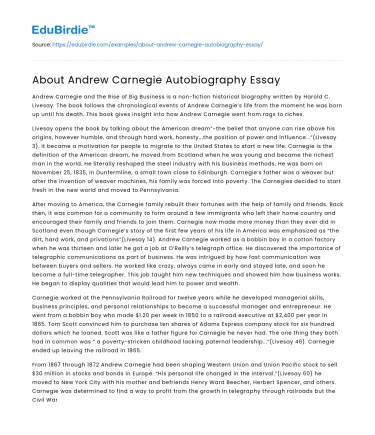Andrew Carnegie and the Rise of Big Business is a non-fiction historical biography written by Harold C. Livesay. The book follows the chronological events of Andrew Carnegie’s life from the moment he was born up until his death. This book gives insight into how Andrew Carnegie went from rags to riches.
Livesay opens the book by talking about the American dream”-the belief that anyone can rise above his origins, however humble, and through hard work, honesty...the position of power and influence...”(Livesay 3). It became a motivation for people to migrate to the United States to start a new life. Carnegie is the definition of the American dream, he moved from Scotland when he was young and became the richest man in the world. He literally reshaped the steel industry with his business methods. He was born on November 25, 1835, in Dunfermline, a small town close to Edinburgh. Carnegie’s father was a weaver but after the invention of weaver machines, his family was forced into poverty. The Carnegies decided to start fresh in the new world and moved to Pennsylvania.
Save your time!
We can take care of your essay
- Proper editing and formatting
- Free revision, title page, and bibliography
- Flexible prices and money-back guarantee
After moving to America, the Carnegie family rebuilt their fortunes with the help of family and friends. Back then, it was common for a community to form around a few immigrants who left their home country and encouraged their family and friends to join them. Carnegie now made more money than they ever did in Scotland even though Carnegie’s story of the first few years of his life in America was emphasized as “the dirt, hard work, and privations”(Livesay 14). Andrew Carnegie worked as a bobbin boy in a cotton factory when he was thirteen and later he got a job at O’Reilly’s telegraph office. He discovered the importance of telegraphic communications as part of business. He was intrigued by how fast communication was between buyers and sellers. He worked like crazy, always came in early and stayed late, and soon he became a full-time telegrapher. This job taught him new techniques and showed him how business works. He began to display qualities that would lead him to power and wealth.
Carnegie worked at the Pennsylvania Railroad for twelve years while he developed managerial skills, business principles, and personal relationships to become a successful manager and entrepreneur. He went from a bobbin boy who made $1.20 per week in 1850 to a railroad executive at $2,400 per year in 1865. Tom Scott convinced him to purchase ten shares of Adams Express company stock for six hundred dollars which he loaned. Scott was like a father figure for Carnegie he never had. The one thing they both had in common was “ a poverty-stricken childhood lacking paternal leadership...”(Livesay 46). Carnegie ended up leaving the railroad in 1865.
From 1867 through 1872 Andrew Carnegie had been shaping Western Union and Union Pacific stock to sell $30 million in stocks and bonds in Europe. “His personal life changed in the interval.”(Livesay 60) he moved to New York City with his mother and befriends Henry Ward Beecher, Herbert Spencer, and others. Carnegie was determined to find a way to profit from the growth in telegraphy through railroads but the Civil War started putting a stop to the construction of the transcontinental railroad.
After the Civil War and reconstruction period, the Gilded Age was formed in New York. Carnegie formed an industry to manufacture Bessemer steel. Tom Miller forms shared ventures with Carnegie in small investments. They formed Freedom Iron Company in 1861 and Carnegie revamped into Freedom Iron and Steel to recreate the Bessemer process in 1866. The process took longer than planned, but by 1868 production started, and expansion was planned in 1872.
Carnegie built an industrial enterprise to become “the best-known manufacturer in the world”(Livesay 109), writing three books, traveling around the world, becoming a philanthropist, and planning to give away his fortune. He finds a wife, and a successor for his business, and considers retirement. At the age of fifty-four, “he surveyed the world from the top”(Livesay 108). He made sales even with a lack of customers during the country’s worst depression by cutting down costs and increasing production.
During Frick’s time with the Carnegie company, it was a difficult time because of the homestead strike in 1892 and then a four-year depression following. When it all blew over, the Carnegie business expanded but the damage to his reputation from the strike never recovered. The cause of the 1893 depression was excess capacity in manufacturing. Carnegie takes two of the eight failing rail mills and sets aggressive policies of cutting down prices to expand sales. He advised his partners “The demand will just fall short of the capacity to produce, therefore a struggle must ensue among producers for orders…”(Livesay 146).
By 1898, Carnegie was successful in securing raw materials in the first stage of the steel industry. In the second stage, the processing of raw materials into steel by means of transport systems. Now he is planning stage three of the finished products, such as railroad cars and boilers. For years Carnegie wanted to retire, but he was determined to come out on top. Eventually, he made it and J.P. Morgan congratulated him on “being the richest man in the world.”(Livesay 188). Carnegie was finally content with his life and later he died of pneumonia.






 Stuck on your essay?
Stuck on your essay?

